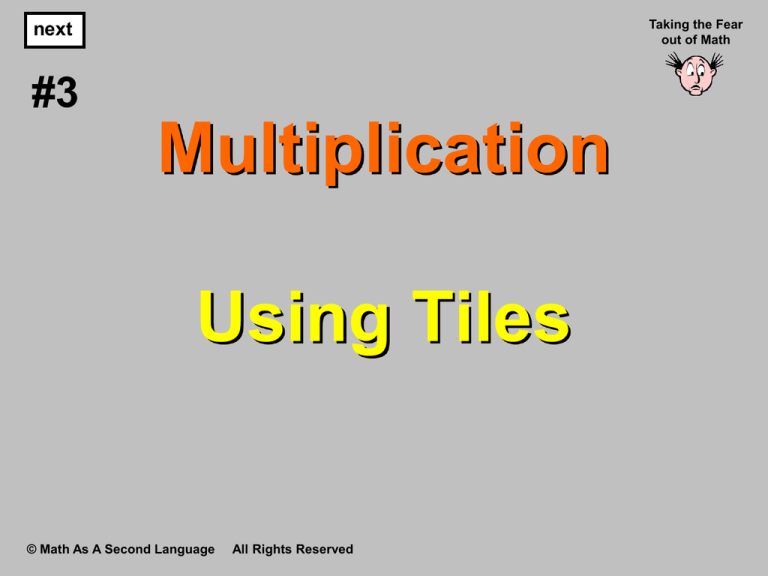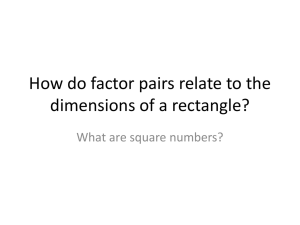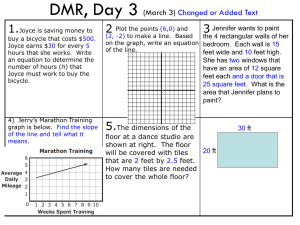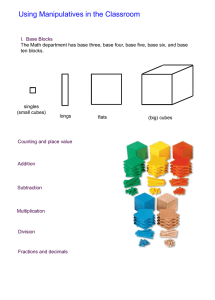
Taking the Fear
out of Math
next
#3
Multiplication
Using Tiles
© Math As A Second Language
All Rights Reserved
next
Tiles and Multiplication
The Egyptians had a numeral
system that was similar to
Roman numerals.
However, unlike the Romans who would
represent the numbers one through nine
by writing…
© Math As A Second Language
All Rights Reserved
next
the Egyptians recognized that by
arranging the tally marks in geometric
patterns, it was easier to recognize the
number. Thus, they might represent
the whole numbers from one to nine by
writing them as…
© Math As A Second Language
All Rights Reserved
next
Using patterns to represent numbers
led to many interesting connections
between number theory, arithmetic,
and geometry.
To make the results
more visual for
young learners it is
helpful to replace the
tally marks by
equally-sized
square tiles.
© Math As A Second Language
All Rights Reserved
next
In this way the tally mark representations
of the numbers one through nine would
become…
© Math As A Second Language
All Rights Reserved
next
The above representations make it rather
easy to see how the tiles can be used to
help students better internalize
multiplication, division, and factoring.
Key
Point
© Math As A Second Language
Given any number of tiles,
they can always be arranged
to form a rectangle, often in
many different ways.
All Rights Reserved
next
For example, given
1 × 12 = 12
12 tiles we can arrange
1 row of 12 tiles each
them in a rectangular
way in any one of six
ways, and each of the
12 × 1 = 12
6 ways is a segue to
12 rows of
multiplication, division
1
1
tile
each
and factorization…
note
Notice that even though 1 × 12 = 12 × 1, one row of twelve tiles does not look like
one column of 12 tiles. They are equal in the sense that the cost is the same if you buy
1 pen for $12 or 12 pens for $1 each, but the two transactions are quite different.
1
© Math As A Second Language
All Rights Reserved
next
Other rectangular combinations
for 12 tiles would be…
2 × 6 = 12
2 rows of 6 tiles each
6 × 2 = 12
6 rows of 2 tiles each
3 × 4 = 12
3 rows of 4 tiles each
4 × 3 = 12
4 rows of 3 tiles each
© Math As A Second Language
All Rights Reserved
next
Visualizing What a Factor Is
When we write 3 × 4 = 12, the traditional
vocabulary is to refer to 12 as the
product of 3 and 4, and to refer to
3 and 4 as factors of 12.
However, by agreeing to represent
whole numbers in terms of square
tiles, there is a more visual way to
view what a factor of a number is.
© Math As A Second Language
All Rights Reserved
next
Visualizing What a Factor Is
For example…
4 is a factor of 12 because 12 tiles
can be arranged into a rectangular
array that consists of 4 rows
(or columns) each with 3 tiles.
7 is a factor of 28 because 28 tiles
can be arranged into a rectangular
array that consists of 7 rows
(or columns) each with 4 tiles.
© Math As A Second Language
All Rights Reserved
next
Two Special Cases
1 is a factor of any number because any
number can be arranged in a rectangular
array that consists of only 1 row.
For example, 13 tiles can be arranged in
1 row that consists of all 13 tiles.
1
13
© Math As A Second Language
All Rights Reserved
next
Two Special Cases
Every number is a factor of itself.
For example, 12 tiles can
be arranged into a
rectangular array
consisting of 12 rows,
each with 1 tile.
12
1
© Math As A Second Language
All Rights Reserved
next
Note
The fact that n = n × 1 = 1 × n for any
number n gives us an interesting insight as
to how numbers can be written as a
product of different factors.
1 tile already exists in the form of a
rectangular array. Namely, it is already
an array that has 1 row that consists of
a single tile.
© Math As A Second Language
All Rights Reserved
next
Note
Other than for 1, every other set of tiles can
be arranged as a rectangular array in at
least 2 ways, namely either as 1 row or
1 column (in the language of factors and
products this simply states that
n = n × 1 = 1 × n).
However, for some sets of tiles these are the
only 2 ways in which they can be arranged
in a rectangular array, and for other sets of
tiles there are additional ways.
© Math As A Second Language
All Rights Reserved
next
Note
For example…
As a rectangular array, 2 tiles
can be arranged only as 2 rows
or 2 columns each with 1 tile.
On the other hand, while 6 tiles
can be arranged as 6 rows or 6
columns each with 1 tile; they
can also be arranged as 3 rows
or columns, each with 2 tiles.
© Math As A Second Language
All Rights Reserved
next
next
Definition
A number greater than 1 is called a prime
number if its only factors are 1 and itself.
In terms of tiles, a number is prime if the
tiles can be represented as a rectangular
array in exactly 2 ways.2
note
2
The tile definition of prime number eliminates 1 from being a prime number
because 1 can be represented in only 1 way as a rectangular array.
© Math As A Second Language
All Rights Reserved
next
next
Definition
A number greater than 1 that is not a prime
number is called a composite number.
In terms of tiles, a number is composite if
the tiles can be represented as a
rectangular array in more than 2 ways.
The number 1 is neither prime nor
composite. It is referred to as a unit.
© Math As A Second Language
All Rights Reserved
next
We will talk about prime and composite
numbers in greater
detail in future presentations.
For now the important point
is that by introducing
properties of numbers in
terms of tiles, even the
youngest students can begin
to internalize important
mathematical concepts
before they are encountered
more abstractly later.
© Math As A Second Language
All Rights Reserved
2×2










